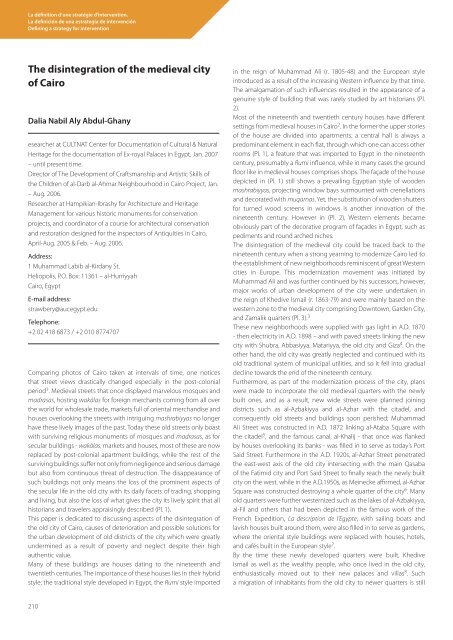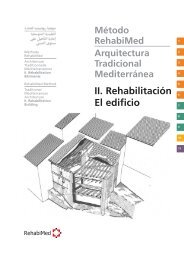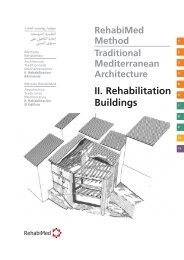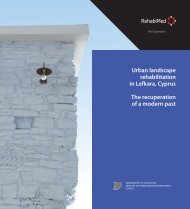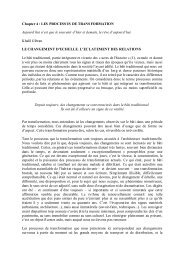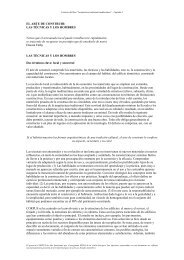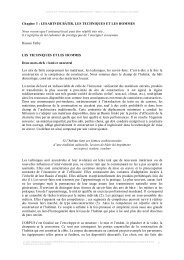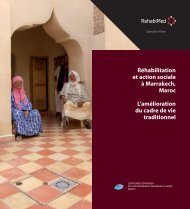La définition d'une stratégie d'intervention. La ... - RehabiMed
La définition d'une stratégie d'intervention. La ... - RehabiMed
La définition d'une stratégie d'intervention. La ... - RehabiMed
Create successful ePaper yourself
Turn your PDF publications into a flip-book with our unique Google optimized e-Paper software.
<strong>La</strong> <strong>définition</strong> d’une <strong>stratégie</strong> d’intervention.<br />
<strong>La</strong> definición de una estrategia de intervención<br />
Defining a strategy for intervention<br />
The disintegration of the medieval city<br />
of Cairo<br />
Dalia Nabil Aly Abdul-Ghany<br />
esearcher at CULTNAT Center for Documentation of Cultural & Natural<br />
Heritage for the documentation of Ex-royal Palaces in Egypt, Jan. 2007<br />
– until present time.<br />
Director of The Development of Craftsmanship and Artistic Skills of<br />
the Children of al-Darb al-Ahmar Neighbourhood in Cairo Project, Jan.<br />
– Aug. 2006.<br />
Researcher at Hampikian-Ibrashy for Architecture and Heritage<br />
Management for various historic monuments for conservation<br />
projects, and coordinator of a course for architectural conservation<br />
and restoration designed for the inspectors of Antiquities in Cairo,<br />
April-Aug. 2005 & Feb. – Aug. 2006.<br />
Address:<br />
1 Muhammad <strong>La</strong>bib al-Kirdany St.<br />
Heliopolis, P.O. Box: 11361 – al-Hurriyyah<br />
Cairo, Egypt<br />
E-mail address:<br />
strawbery@aucegypt.edu<br />
Telephone:<br />
+2 02 418 6873 / +2 010 8774707<br />
Comparing photos of Cairo taken at intervals of time, one notices<br />
that street views drastically changed especially in the post-colonial<br />
period 1 . Medieval streets that once displayed marvelous mosques and<br />
madrasas, hosting for foreign merchants coming from all over<br />
the world for wholesale trade, markets full of oriental merchandise and<br />
houses overlooking the streets with intriguing mashrabiyyas no longer<br />
have these lively images of the past. Today these old streets only boast<br />
with surviving religious monuments of mosques and madrasas, as for<br />
secular buildings - , markets and houses, most of these are now<br />
replaced by post-colonial apartment buildings, while the rest of the<br />
surviving buildings suffer not only from negligence and serious damage<br />
but also from continuous threat of destruction. The disappearance of<br />
such buildings not only means the loss of the prominent aspects of<br />
the secular life in the old city with its daily facets of trading, shopping<br />
and living, but also the loss of what gives the city its lively spirit that all<br />
historians and travelers appraisingly described (Pl. 1).<br />
This paper is dedicated to discussing aspects of the disintegration of<br />
the old city of Cairo, causes of deterioration and possible solutions for<br />
the urban development of old districts of the city which were greatly<br />
undermined as a result of poverty and neglect despite their high<br />
authentic value.<br />
Many of these buildings are houses dating to the nineteenth and<br />
twentieth centuries. The importance of these houses lies in their hybrid<br />
style; the traditional style developed in Egypt, the Rumi style imported<br />
in the reign of Muhammad Ali (r. 1805-48) and the European style<br />
<br />
<br />
genuine style of building that was rarely studied by art historians (Pl.<br />
2).<br />
Most of the nineteenth and twentieth century houses have different<br />
settings from medieval houses in Cairo 2 . In the former the upper stories<br />
of the house are divided into apartments; a central hall is always a<br />
<br />
rooms (Pl. 1), a feature that was imported to Egypt in the nineteenth<br />
century, presumably a Rumi<br />
<br />
depicted in (Pl. 1) still shows a prevailing Egyptian style of wooden<br />
mashrabiyyas, projecting window bays surmounted with crenellations<br />
and decorated with muqarnas. Yet, the substitution of wooden shutters<br />
for turned wood screens in windows is another innovation of the<br />
nineteenth century. However in (Pl. 2), Western elements became<br />
obviously part of the decorative program of façades in Egypt, such as<br />
pediments and round arched niches.<br />
The disintegration of the medieval city could be traced back to the<br />
nineteenth century when a strong yearning to modernize Cairo led to<br />
the establishment of new neighborhoods reminiscent of great Western<br />
cities in Europe. This modernization movement was initiated by<br />
Muhammad Ali and was further continued by his successors, however,<br />
major works of urban development of the city were undertaken in<br />
the reign of Khedive Ismail (r. 1863-79) and were mainly based on the<br />
western zone to the medieval city comprising Downtown, Garden City,<br />
and Zamalik quarters (Pl. 3). 3<br />
These new neighborhoods were supplied with gas light in A.D. 1870<br />
- then electricity in A.D. 1898 – and with paved streets linking the new<br />
city with Shubra, Abbasiyya, Matariyya, the old city and Giza 4 . On the<br />
other hand, the old city was greatly neglected and continued with its<br />
old traditional system of municipal utilities, and so it fell into gradual<br />
decline towards the end of the nineteenth century.<br />
Furthermore, as part of the modernization process of the city, plans<br />
were made to incorporate the old medieval quarters with the newly<br />
built ones, and as a result, new wide streets were planned joining<br />
districts such as al-Azbakiyya and al-Azhar with the citadel, and<br />
consequently old streets and buildings soon perished; Muhammad<br />
Ali Street was constructed in A.D. 1872 linking al-Ataba Square with<br />
the citadel 5 <br />
by houses overlooking its banks - was filled in to serve as today’s Port<br />
Said Street. Furthermore in the A.D. 1920s, al-Azhar Street penetrated<br />
the east-west axis of the old city intersecting with the main Qasaba<br />
of the Fatimid city and Port Said Street to finally reach the newly built<br />
city on the west, while in the A.D.1950s, as Meinecke affirmed, al-Azhar<br />
Square was constructed destroying a whole quarter of the city 6 . Many<br />
old quarters were further westernized such as the lakes of al-Azbakiyya,<br />
al-Fil and others that had been depicted in the famous work of the<br />
French Expedition, <strong>La</strong> description de l’Egypte, with sailing boats and<br />
lavish houses built around them, were also filled in to serve as gardens,<br />
where the oriental style buildings were replaced with houses, hotels,<br />
and cafés built in the European style 7 .<br />
By the time these newly developed quarters were built, Khedive<br />
Ismail as well as the wealthy people, who once lived in the old city,<br />
enthusiastically moved out to their new palaces and villas 8 . Such<br />
a migration of inhabitants from the old city to newer quarters is still<br />
210


